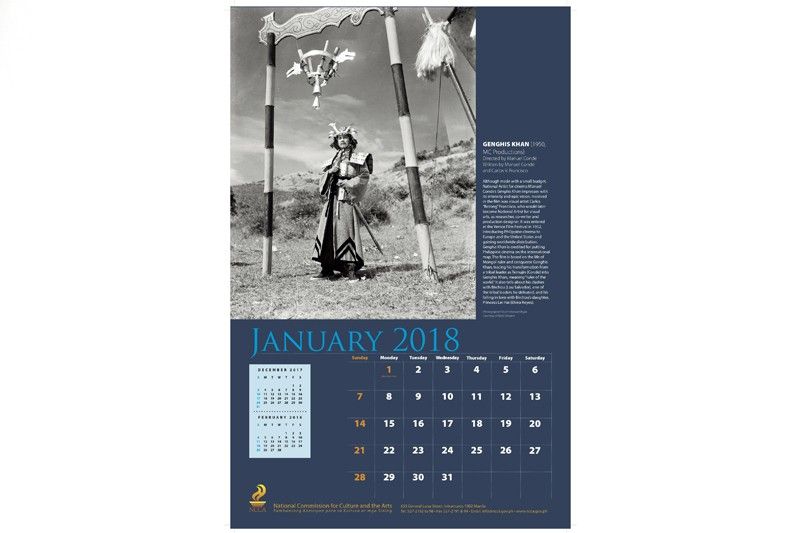A Calendar Celebrates Philippine Cinema


Genghis Khan is one of the films featured on the NCCA 2018 calendar.
As part of its commemoration of “100 Years of Philippine Cinema,” the National Commission for Culture and the Arts (NCCA) has selected a dozen classic Filipino films for its 2018 wall calendar.
Spanning over three decades, from 1950 to 1982, the choices are seen to represent “the most important and iconic films from what are considered as the first Golden Age (late 1940s to mid-’60s decade) and second Golden Age (mid-’70s to early ’80s decade) of Philippine cinema by film scholars.”
Teddy Co, head of the NCCA Subcommission on the Arts (Cinema), writes further. “These were eras that for different reasons, resulted in generous bursts of creativity among Filipino filmmakers.”
Representative stills from the 12 film productions are partnered with each of the calendar months from January to December, with some informative text on each production also provided.
The films are listed in the following order:
Genghis Khan (1950, MC Productions) Directed by Manuel Conde. Written by Manuel Conde and Carlos V. Francisco.
Anak Dalita (1956, LVN Pictures) Directed by Lamberto V. Avellana. Written by Rolf Bayer.
Biyaya ng Lupa (1959, LVN Pictures) Directed by Manuel Silos. Written by Celso Al. Carunungan and Pablo Naval.
Ang Daigdig ng mga Api (1965, Cinemasters Inc.) Directed by Gerardo de Leon. Written by Pierre L. Salas.
Maynila sa Mga Kuko ng Liwanag (1975, Cinema Artists Philippines) Directed by Lino Brocka. Written by Clodualdo del Mundo, Jr.
Ganito Kami Noon… Paano Kayo Ngayon? (1976, Hemisphere Pictures, Inc.) Directed by Eddie Romero. Written by Roy C. Iglesias and Eddie Romero.
Mababangong Bangungot (1977) Written and directed by Kidlat Tahimik.
Manila by Night (City After Dark) (1980, Regal Films) Written and directed by Ishmael Bernal.
Ang Panday (1980, FPJ Productions) Directed by Fernando Poe, Jr. Written by Carlo J. Caparas and Fred Navarro, based on the characters of Caparas’ komiks series.
Kisapmata (1982, Bancom Audiovision) Directed by Mike de Leon. Written by Clodualdo del Mundo Jr., Raquel N. Villavicencio and Mike de Leon.
Oro Plata Mata (1982, Experimental Cinema of the Philippines) Directed by Peque Gallaga. Written by Jose Javier Reyes.
Moral (1982, Seven Stars Production) Directed by Marilou Diaz-Abaya. Written by Ricardo Lee.
Any selection naturally raises eyebrows and disputation. To NCCA’s credit, these choices aren’t tagged as “the best 12” of all time, including the present. Co is careful to say that these are only “some of the important and iconic films” from those two reputed “Golden Ages.”
Actually, the centennial commemoration of Philippine cinema started last year and will cover a two-and-a-half year period from 2017 to 2019. This corresponds “to the time of the establishment of the first Filipino film company in May 1917, until the theatrical release of the first Filipino-made feature in September 1919.”
It was on May 15, 1917 when Jose Nepomuceno established the first Filipino-owned movie company, Malayan Movies. He went on to make “the first Filipino theatrical narrative film, Dalagang Bukid, which was first shown on September 12, 1919, at the Teatro de la Comedia before moving to the Empire Theater.”
One may thus argue that this first-ever calendar to honor local cinema could well have included, or even started with, a tribute to Jose Nepomuceno. But as Co explains, the decision was made to choose films from the Golden Eras. Thus, the first four represent the first Golden Era, and the other eight the second.
It will also be noted that each of the seven National Artists for Cinema have been included: Avellana, Gerardo de Leon, Brocka, Bernal, Romero, Poe and Manuel Conde. This may explain the inclusion of Poe’s Ang Panday, although many will agree that it is indeed an iconic film, as I would. The same may be said of Mababangong Bangungot, which most non-cineastes may not be familiar with.
One film that strikes me as surprisingly missing from the list is 1977’s Burlesk Queen, written and directed by Celso Ad. Castillo. And for a Mike de Leon film, I might prefer 1984’s Sister Stella L., with screenplay by Mike de Leon, Jose F. Lacaba and Jose Almojuela.
But then again, having two Vilma Santos starrers would only raise a howl from Noranians, who might be hard-pressed to argue that Bernal’s Himala (1982) is a better choice than Manila By Night.
In any case, Teddy Co assures everyone:
“More films would have been represented, but there are only twelve months in a year. The numerous award-winning digital masterpieces of the 21st century could also not be accommodated yet, but perhaps they will be featured for another calendar year.”
Well then, we can still hope that NCCA comes up with more of such calendars, so that apart from Celso Ad. Castilllo, Mario O’Hara, Behn Cervantes, Laurice Guillen, Tikoy Aguiluz (among others), and the likes of Henry Francia, Nick Deocampo, Raymond Red, up to Brillante Mendoza, Lav Diaz and all other outstanding contemporary filmmakers may be similarly honored. And of course other lady directors (including documentary filmmakers) ought to shore up that initial single inclusion of Marilou Diaz-Abaya.



















